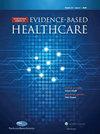在成人围手术期环境中管理和/或预防低体温策略的有效性:系统综述。
Q3 Medicine
International Journal of Evidence-Based Healthcare
Pub Date : 2010-07-15
DOI:10.11124/01938924-201008190-00001
引用次数: 4
摘要
背景:在外科手术过程中,患者的体温过低是很常见的。围手术期环境中的低温可能有许多不希望的生理影响,这些影响与术后显著的发病率有关。在麻醉的第一个小时内,由于体温调节机制受损,患者在手术室内受凉,患者体温降至35℃以下。因此,在围手术期工作的卫生保健专业人员需要知道什么是治疗或预防低体温的最有效策略,以改善手术后患者的预后。然而,到目前为止,尚无高质量随机对照试验的有效性系统评价,以确定围手术期环境中预防和/或管理低体温的有效策略。本系统综述的目的是确定术中和术后手术护理阶段预防和/或处理低温的最有效策略。数据来源我们对从成立到2008年10月的电子数据库进行了全面的检索,包括Cochrane library、MEDLINE、PubMed、CENTRAL、CINAHL、Current contents connect、DARE、Dissertations Abstract International、EMBASE、Scopus和TRIP。搜索只限于英语语言。综述方法寻求随机对照试验或临床对照试验,评估主动或被动加热技术在预防和/或治疗非故意低体温中的有效性。使用乔安娜布里格斯研究所的关键评估工具对研究质量进行了关键评估。数据提取是通过乔安娜布里格斯研究所的标准数据提取表来证明有效性的。结果纳入18项研究,共1451例患者。结果被分为三类,并在主动增温技术类别中进一步细分。1. 主动升温技术被动升温技术药物干预。与被动加热、常规热护理和无任何形式的加热相比,强制空气加热在维持术中体温正常方面是有效的。在局部麻醉下剖腹产的孕妇被强制加热空气,以防止母婴体温过低。相比之下,在同一患者群体中,用紧绷的弹性绷带包裹腿(被动保温)的被动加热在预防产妇体温过低方面没有显着的好处。然而,在关节镜下膝关节手术患者中,强制空气加热并没有导致术后寒战发生率的降低,这表明在该患者群体中,将主动加热延长至康复期是不有效或不可行的。强制空气加热比循环水褥垫在预防肾下动脉瘤修复患者体温过低方面更有效。在较长的手术过程中,强制空气加热对维持术中体温正常是有效的。在不同的患者群体中进行预热可以防止再分配低体温,特别是在麻醉诱导一小时后。通过不同的液体加热装置(干加热和水加热)将静脉和灌洗液加热(38-40°C)至高于室温的温度,在稳定的血流动力学变量和手术(经尿道前列腺切除术和骨科手术)结束时较高的核心温度(核心T)方面,对患者显著有益。然而,在膝关节镜患者中使用预热冲洗液并不能维持体温正常。水衣加温对维持原位肝移植患者术中体温的效果显著(P < 0.05)。与常规热疗相比,强制空气加温可有效减少手术伤口感染和术后心脏并发症的发生率,并缩短住院时间。用反射加热毯或弹性绷带紧紧包裹腿部的被动加热被发现对降低低体温的发生率或程度无效。低流量麻醉截断至600字本文章由计算机程序翻译,如有差异,请以英文原文为准。
The effectiveness of strategies for the management and/or prevention of hypothermia within the adult perioperative environment: systematic review.
Background
Inadvertent hypothermia is common in patient’s undergoing surgical procedures. Hypothermia within the perioperative environment may have many undesired physiological effects that are associated with significant postoperative morbidity. Patient’s temperature drops to below 35°C during the first hour of anaesthesia because of impaired thermoregulatory mechanism and patient getting cold in the operating theatre. For this reason, health care professionals working in the perioperative environment need to know what are the most effective strategies for treating or preventing hypothermia to improving patient outcomes following surgical procedures. However, to date there has been no systematic review of effectiveness with high quality randomised controlled trials to identify effective strategies for the prevention and/or management of hypothermia in the perioperative environment.
Objective
The objective of this systematic review was to identify the most effective strategies for the prevention and/or management of hypothermia in the intraoperative and postoperative phases of surgical care.
Data sources
A comprehensive search was undertaken on electronic databases from their inception to October 2008, including Cochrane library, MEDLINE, PubMed, CENTRAL, CINAHL, Current contents connect, DARE, Dissertations Abstract International, EMBASE, Scopus, and TRIP. The search was restricted to English language.
Review methods
Randomised controlled trials or clinical controlled trials were sought, which evaluated the effectiveness of active or passive warming techniques in the prevention and/or treatment of inadvertent hypothermia. Critical appraisal of study quality was undertaken using Joanna Briggs Institute critical appraisal instruments. Data extraction was via the Joanna Briggs Institute standard data extraction form for evidence of effectiveness.
Results
Eighteen studies with a combined 1451 patients were included. The results were classified into three categories with a further sub classification within the active warming techniques category.
1. Active warming techniques
2. Passive warming techniques
3. Medication intervention.
Forced air warming was effective in maintaining intraoperative normothermia when compared to passive warming, routine thermal care and no form of warming. Forced air warming in pregnant women scheduled for caesarean delivery under regional anaesthesia prevented maternal and foetal hypothermia. In contrast, passive warming with tight elastic bandages wrapped around the legs (passive insulation) in the same patient population had no significant benefits in preventing maternal hypothermia.
However, in arthroscopic knee surgery patients, forced air warming did not result in a decrease in the incidence of postoperative shivering indicating that it was not effective or feasible to extend active warming into recovery in this patient population. Forced air warming was effective than circulating water mattress in preventing hypothermia in patients who underwent repair of infrarenal aortic aneurysms. Forced air warming was effective against radiant warming in maintaining intraoperative normothermia in lengthier surgical procedures.
Prewarming in different patient populations prevents redistribution hypothermia, especially after one hour of anaesthesia induction. Intravenous and irrigating fluids warmed (38-40°C) to a temperature higher than that of room temperature by different fluid warming devices (both dry and water heated) proved significantly beneficial to patients in terms of stable haemodynamic variables, and higher core temperature (core T) at the end of the surgery (transurethral prostatectomy and orthopaedic surgery). However, prewarming irrigation fluids in knee arthroscopy patients did not prove beneficial in maintaining normothermia.
Water garment warmer was significantly (P < 0.05) effective than forced air warming in maintaining intraoperative normothermia in orthotopic liver transplantation patients. Extra warming with forced air compared to routine thermal care was effective in reducing the incidence of surgical wound infections and postoperative cardiac complications, as well as shorten the length of hospital stay.
Passive warming with reflective heating blankets or elastic bandages wrapped around the legs tightly were found to be ineffective in reducing the incidence or magnitude of hypothermia. Low-flow anaesthesia TRUNCATED AT 600 WORDS
求助全文
通过发布文献求助,成功后即可免费获取论文全文。
去求助
来源期刊

International Journal of Evidence-Based Healthcare
Medicine-Health Policy
CiteScore
1.80
自引率
0.00%
发文量
39
期刊介绍:
The International Journal of Evidence-Based Healthcare is the official journal of the Joanna Briggs Institute. It is a fully refereed journal that publishes manuscripts relating to evidence-based medicine and evidence-based practice. It publishes papers containing reliable evidence to assist health professionals in their evaluation and decision-making, and to inform health professionals, students and researchers of outcomes, debates and developments in evidence-based medicine and healthcare.
The journal provides a unique home for publication of systematic reviews (quantitative, qualitative, mixed methods, economic, scoping and prevalence) and implementation projects including the synthesis, transfer and utilisation of evidence in clinical practice. Original scholarly work relating to the synthesis (translation science), transfer (distribution) and utilization (implementation science and evaluation) of evidence to inform multidisciplinary healthcare practice is considered for publication. The journal also publishes original scholarly commentary pieces relating to the generation and synthesis of evidence for practice and quality improvement, the use and evaluation of evidence in practice, and the process of conducting systematic reviews (methodology) which covers quantitative, qualitative, mixed methods, economic, scoping and prevalence methods. In addition, the journal’s content includes implementation projects including the transfer and utilisation of evidence in clinical practice as well as providing a forum for the debate of issues surrounding evidence-based healthcare.
 求助内容:
求助内容: 应助结果提醒方式:
应助结果提醒方式:


